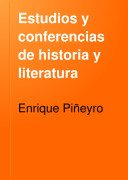3.7 Development and exponents of literary criticism in the period 1868 – 1898

Literary criticism from the war and interwar periods, although broadly based on the same theoretical concepts, changed considerably after the Pact of Zanjón, corresponding to a certain extent to the ideological spectrum within which Cuban society moved at that time.
In this sense, emigration had marked a split in that the most revolutionary sector of society concentrated abroad and, from a literary point of view, assumed the essence of literature, which is creation itself, while on the Island, activities of literary analysis and criticism were fundamentally developed, without diminishing the importance of studies of this kind, but which are nourished primarily by the expressions of creative work.
During this period, the critical side of Enrique José Varona emerges, who also explored other literary circles, as does Enrique Piñeyro and Manuel Sanguily, intellectuals who were truly integral to the era.
The critical contributions of these authors are usually found intertwined in their journalism and also in the political proselytism they developed, in works that are addressed in the sections corresponding to political oratory, essays, and historiography.
Other critics who set the tone at the time were Ricardo del Monte, Rafael María Merchán, Rafael Montoro, Aniceto Valdivia, Manuel de la Cruz, Emilio Bobadilla, Aurelio Mitjans and José de Armas y Cárdenas, in whose texts one can trace the main itineraries followed in Cuba by the literary currents and theories current in the world.
Cuban literary criticism was not detached from the prevailing canon in Latin America, where positivism aroused great enthusiasm as it allowed for the creation of an illusion of objectivity.
In addition to the most lucid literary researchers already mentioned, a trenchant criticism also proliferated, targeting even the personalities and lives of authors, characterized by a priori judgments and a lack of scientific support. In this sense, positivism, with its inherent biases, initially constituted a step forward for the body of ideas on literary criticism, as well as philology and linguistics.








